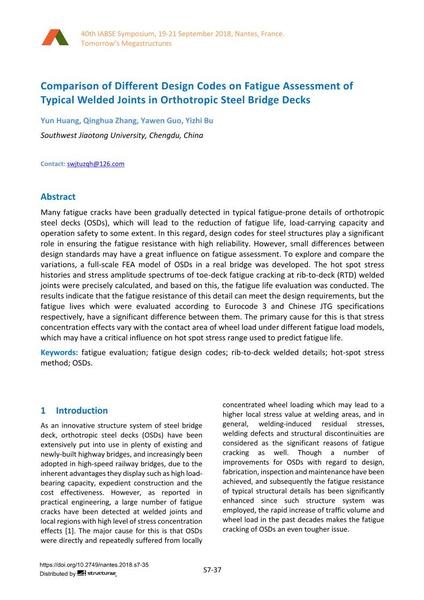Comparison of Different Design Codes on Fatigue Assessment of Typical Welded Joints in Orthotropic Steel Bridge Decks

|
|
|||||||||||
Détails bibliographiques
| Auteur(s): |
Yun Huang
(Southwest Jiaotong University, Chengdu, China)
Qinghua Zhang (Southwest Jiaotong University, Chengdu, China) Yawen Guo (Southwest Jiaotong University, Chengdu, China) Yizhi Bu (Southwest Jiaotong University, Chengdu, China) |
||||
|---|---|---|---|---|---|
| Médium: | papier de conférence | ||||
| Langue(s): | anglais | ||||
| Conférence: | IABSE Symposium: Tomorrow’s Megastructures, Nantes, France, 19-21 September 2018 | ||||
| Publié dans: | IABSE Symposium Nantes 2018 | ||||
|
|||||
| Page(s): | S7-35 | ||||
| Nombre total de pages (du PDF): | 8 | ||||
| DOI: | 10.2749/nantes.2018.s7-35 | ||||
| Abstrait: |
Many fatigue cracks have been gradually detected in typical fatigue-prone details of orthotropic steel decks (OSDs), which will lead to the reduction of fatigue life, load-carrying capacity and operation safety to some extent. In this regard, design codes for steel structures play a significant role in ensuring the fatigue resistance with high reliability. However, small differences between design standards may have a great influence on fatigue assessment. To explore and compare the variations, a full-scale FEA model of OSDs in a real bridge was developed. The hot spot stress histories and stress amplitude spectrums of toe-deck fatigue cracking at rib-to-deck (RTD) welded joints were precisely calculated, and based on this, the fatigue life evaluation was conducted. The results indicate that the fatigue resistance of this detail can meet the design requirements, but the fatigue lives which were evaluated according to Eurocode 3 and Chinese JTG specifications respectively, have a significant difference between them. The primary cause for this is that stress concentration effects vary with the contact area of wheel load under different fatigue load models, which may have a critical influence on hot spot stress range used to predict fatigue life. |
||||
